The exhibition “Bones” will display the art and vision of Yasuo Tanaka during a consecutive three day opening at the Book Beat gallery/bookstore on Friday, October 21st from 6-8 PM, Saturday, October 22nd from 5-8 PM and Sunday from 3-5 PM. The artist will be making “portraits in a wheelchair” during his residency and will have original sculptures, ink napkin drawings, photographs and books for sale. Artist Dick Cruger will also be in attendance and will present their collaboration Parallel Universe, a photographic book correspondence between Tokyo and Detroit. The Book Beat gallery is located at 26010 Greenfield in Oak Park. Please call 248-968-1190 for more information.
Tokyo artist Yasuo Tanaka (b.1942) is a uniquely gifted artist that uses bookmaking, design, puppetry, wire sculpture, photography, and ink drawing in fantastic and striking combinations. Tanaka has produced a curious and quietly poetic body of work, a bizarrely stylized skeleton world radiating a simple universal message and philosophy. A surreal, childlike, and humorous quality pervades all of Tanaka’s art that presents a metaphysical transient vision about eternity, death and life wrapped inside a purely visual reality.
Detroit book artist and sculptor Dick Cruger, began a friendship with the artist Yasuo Tanaka about 10 years ago. Cruger was introduced to Yasuo through the American poet Arthur Barnard who now lives in Tokyo. Barnard thought the two artists should meet since they both shared similar aesthetics. Each artist executes work with technical polish, working in similar areas of whimsical storytelling through visual art, books, and sculpture. They recently collaborated on Parallel Universes, a book project that combines sites of Detroit and Tokyo told through skeleton and robot figures. The Book Beat gallery will display this body of work and hold the book launch on October 21st.
Tanaka’s small and delicate Tokyo Midnight, is an oblong hand-sewn book of 24 photographs of puppet skeletons posed around nightly urban Tokyo scenes. The title is typewritten on an opaque sheet of paper that covers a small die-cut square on thick black cardstock that serves as the book’s cover. The skull of the first skeleton is revealed in a tiny die-cut window as if it is trying to enter another world or peak into ours… as you open the book there is a dusky scene on the first page, the beginning of a sunrise or sunset. A small moon rests high in the night sky. The skeleton subject looks tired of life and exhausted, its skull bent over drooping, perhaps returning home from a night of drinking, photographing, or a long night of witnessing the action found inside of Midnight Tokyo. We don’t know if the figure is arriving or departing. The ambiguous improvisational nature of Midnight Tokyo describes a multi-level netherworld open to many interpretations.
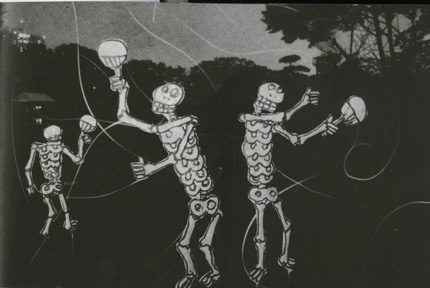 Midnight Tokyo begins with isolated single skeletons; figures alone and lost in thought, one sits at a dinner with a coffee mug watching a clock tick by overhead. A sense of time passing by and the daily grind gradually gives way to groups of outdoor skeleton’s drinking, buying magazines at a midnight kiosk, a more frenzied group action picks up the pace; fashionable skeletons a strolling down the street clutch expensive name-brand handbags, a group plays a paddle ball game in the park, a large crowd of skeletons sit watching and cheering on a boxing match of skeletons, a cozy skeleton couple sits on a park bench reading a book as a pair of inexplicable wooden shows sit empty on the brick walkway. There are scenes of game playing, music performances, a figure photographing roses, a bicyclist in front of a lit up model of the Eiffel Tower, a night ball game, a rainstorm with broken umbrellas, a boat ride down a river, death figures running and exercising. The last image is large ball, or a sun? or perhaps an entire world of skeletons rising (or setting) over the city as the cross of a church illuminates the urban night sky.
Midnight Tokyo begins with isolated single skeletons; figures alone and lost in thought, one sits at a dinner with a coffee mug watching a clock tick by overhead. A sense of time passing by and the daily grind gradually gives way to groups of outdoor skeleton’s drinking, buying magazines at a midnight kiosk, a more frenzied group action picks up the pace; fashionable skeletons a strolling down the street clutch expensive name-brand handbags, a group plays a paddle ball game in the park, a large crowd of skeletons sit watching and cheering on a boxing match of skeletons, a cozy skeleton couple sits on a park bench reading a book as a pair of inexplicable wooden shows sit empty on the brick walkway. There are scenes of game playing, music performances, a figure photographing roses, a bicyclist in front of a lit up model of the Eiffel Tower, a night ball game, a rainstorm with broken umbrellas, a boat ride down a river, death figures running and exercising. The last image is large ball, or a sun? or perhaps an entire world of skeletons rising (or setting) over the city as the cross of a church illuminates the urban night sky.
Yasuo beautifully blends in pen-light sketching trails in many of his photos, a technique once made popular in Picasso’s light action drawings from a photographic sequence and film made by Gjon Mili. Tokyo Midnight is a poetic book of gestures whose power belies its small format and quaint/whimsical qualities. The book is able to use light and darkness in a strong dramatic effect. The work alters our perception of space and depth of field as it subverts our notion of reality, time, life and death. There are no digital effects or photoshop software used in Yasuo’s work. Each image has been carefully thought out and composed before it was taken.
Attaching a long wire handle to his puppet subjects, Tanaka is able to make his skeletons dance and perform activities in synchronicity with reality. His stage is the rectangular frame of his camera set still on a tripod. Known to travel to Europe with his puppets and tripod camera, Tanaka often sets up among crowds, often preferring to shoot theatrical scenes at nighttime with long open-lens exposures. The photo works make obvious the close connection between the living world and the dead, between the inanimate and the movement of daily life. Tanaka’s shadow worlds are printed in black and white to emphasize the contrasts of light and dark, of white bone against the night. The circular patterns of the book creates a movement of time from indoor personal/private space to public shared space and the madness of crowds. Light shows are an aggressive ongoing element throughout Midnight Tokyo. There are fireworks, lit up skyscrapers, reflections, paper lanterns, neon lights, sun, moon and pen-light drawings. The artist is hyper-conscious of light and composition -and the sublime effect it plays in photography.
Yasuo’s handmade books are produced in small editions. He uses fine art printing techniques like continuous tone gravure or hand etchings. The papers and bindings are selected to best reflect on their contents. Tanaka who was once a freelance commercial designer, creates simple black wire figures that he sculpts into 3-dimensional form.He calls these sculpture-drawings, and photographed against a white ground they give an impression of drawings in 3-dimensions.. The skeletons and insect creatures he makes with thin black wire add another dimension to his art. As small miniature sculptural puppets and creatures, each stands alone as finely crafted objects.
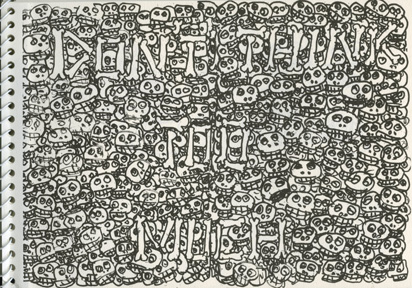 Another of Yasuo’s small books is titled One Million One Skeletons. This book of drawings is spiral bound and contains eight fold-out accordion pages, each folded 6 times and printed on both sides making 96 pages. Each page contains an idea or meditation on the group. There are similar pastimes being examined as in the photographs, yet some sketches also convey a dance or sexual intercourse being performed like instructional positions in a kama sutra book. The swirling ball of skeletons is also present and the message begins to read more chaotic and “group think” then in the fun-loving photography series. One page commands spelling out the words “DON’T THINK TOO MUCH” in bones over a sea of skulls. It is one of the rare instances that the artist uses words. Is the artist implying thought leads to death or that we should not think about or insert meaning into these drawings – that we should divorce meaning from the visual? The drawings bring to mind the Day of the Dead rituals of Mexico and the great political skeleton broadsides by Josè Guadalupe Posada. But where Posada infused personalities and the sensational in his grotesques, Yasuo manages a more quiet humorous approach, his cartoons reflect aspects of Japanese society and the idea of working, standing and playing together as a unit. The bones of Tanaka march together in formal unison creating a repetitive pop landscape of numbness, imprisonment, and group interaction. The skeletons forming an orderly yet imaginative vision of Japan.
Another of Yasuo’s small books is titled One Million One Skeletons. This book of drawings is spiral bound and contains eight fold-out accordion pages, each folded 6 times and printed on both sides making 96 pages. Each page contains an idea or meditation on the group. There are similar pastimes being examined as in the photographs, yet some sketches also convey a dance or sexual intercourse being performed like instructional positions in a kama sutra book. The swirling ball of skeletons is also present and the message begins to read more chaotic and “group think” then in the fun-loving photography series. One page commands spelling out the words “DON’T THINK TOO MUCH” in bones over a sea of skulls. It is one of the rare instances that the artist uses words. Is the artist implying thought leads to death or that we should not think about or insert meaning into these drawings – that we should divorce meaning from the visual? The drawings bring to mind the Day of the Dead rituals of Mexico and the great political skeleton broadsides by Josè Guadalupe Posada. But where Posada infused personalities and the sensational in his grotesques, Yasuo manages a more quiet humorous approach, his cartoons reflect aspects of Japanese society and the idea of working, standing and playing together as a unit. The bones of Tanaka march together in formal unison creating a repetitive pop landscape of numbness, imprisonment, and group interaction. The skeletons forming an orderly yet imaginative vision of Japan.
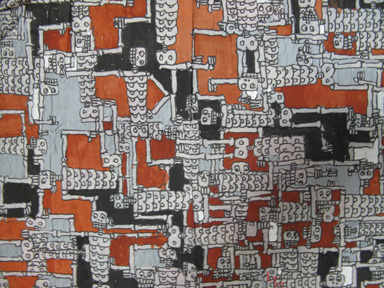 In one of his rare statements, Tanaka has indicated that these idiosyncratic folk-like drawings are derived from the idea that the skeleton is our one final similarity, the foundation of form contained by all humanity. The skeleton crosses (and eliminates) all borders of nationality, race, class, culture, and religion. The skeleton is our shadow and lasting statement on the planet. Tanaka’s skeletons however are far from dead or distant objects. They are animated dead-beings; the bones and raw embodiment of daily life.
In one of his rare statements, Tanaka has indicated that these idiosyncratic folk-like drawings are derived from the idea that the skeleton is our one final similarity, the foundation of form contained by all humanity. The skeleton crosses (and eliminates) all borders of nationality, race, class, culture, and religion. The skeleton is our shadow and lasting statement on the planet. Tanaka’s skeletons however are far from dead or distant objects. They are animated dead-beings; the bones and raw embodiment of daily life.
Tanaka’s miniatures have a similar relationship to the real-life decorative bone tableau’s in the five chapels at the Cemetery of the Capuchins built in Rome by an anonymous friar in the 1500s. Tanaka’s skeletons too are seen in everyday activity; eating, playing sports, relaxing, being human. The individual is carefully dissolved by Tanaka’s treatment and what emerges is a kind of homogenous and lively death figure of community activity; a bony image that’s both a single building block (of the architecture of society) and its own universe. Tanaka conveys both the micro and macro, saying something impregnated with cosmic meaning, yet doing it quietly, in a medium he has created himself and made his own.
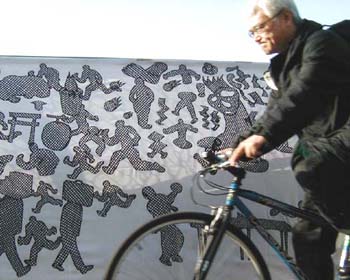 The mysterious mazes within Tanaka’s work create a landscape of thinking about death, an opening to the idea that death might even hold onto the same drudgery, incarceration, pain, and drunkenness as in life, a message that stands clearly beside the artist’s own statement of unity, fulfillment and joy.
The mysterious mazes within Tanaka’s work create a landscape of thinking about death, an opening to the idea that death might even hold onto the same drudgery, incarceration, pain, and drunkenness as in life, a message that stands clearly beside the artist’s own statement of unity, fulfillment and joy.
Tanaka’s vision recalls classical Ukiyo-e ghost drawings and their often demented manga offspring. The magical bone writing of Tanaka seem to follow their own codex-like logic as in the mysterious flattened pre-Columbian Mayan hieroglyphics. With Tanaka, the repetitive multiplied symbol of death is taken to extremes of cubist abstraction and chaos, suggesting a perpetual struggle or battle with harmony and order. There is also something reminiscent of mobile sculptor Alexander Calder’s miniature circus in the works of Tanaka, each artist content in making self-contained gentle vistas that express life in a transcendent magical way.
For many years Tanaka has been obsessively compiling hundreds, perhaps thousands of his drawings of human skeletons and figures on the surface of delicate paper napkins. They are labyrinthian objects of order in a private ephemeral diary – images that hold the memories of past meals and journeys. His drawings contain a magical language that echo again in his photographs. The nearly weightless napkins are generally about 8 inches square and are unfolded to a surface of about 20″-24″ square. The artist carefully inks and colors-in images on all quadrants of the translucent square. The initial black outlines act as a border to contain the color. His life’s work fits comfortably inside a small suitcase.
Napkins that are padded underneath the original drawing serve to soak up the ink and watercolors. These formless “blotter” napkins serve as further canvas for his cartoon/comic ink sketches and offbeat abstractions. He wastes nothing. Tanaka spends countless hours skimming the surface on the thin translucent skins of napkins. A misplaced line or last minute error can completely ruin a work, but the under-napkins may still yield a successful accidental work, a dadaist, surreal strategy of chance. Often the names of restaurants and advertising logos will show through on the napkins reminding us of the temporal and pop nature of these disposable feather-light paper treasures. The Napkin – once a disposable object meant to wipe our faces and clean up stains have been given new dignity and substance as a container for ideas.
Book Beat will be hosting the first United States exhibition of Yasuo Tanaka’s artistry.

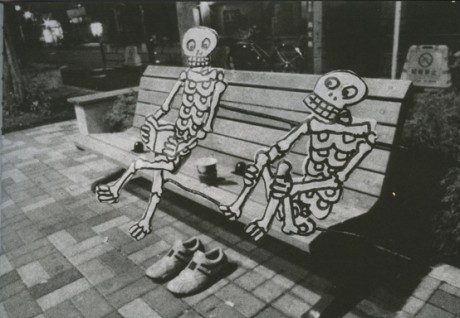
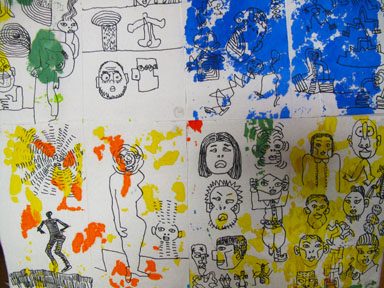
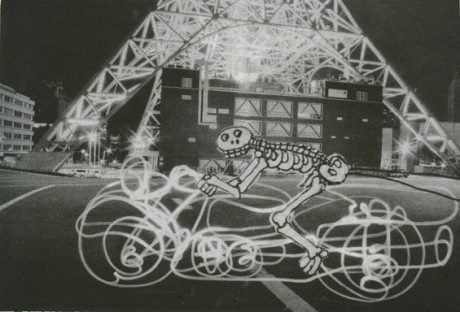
I can’t wait to see this work. Amazing.
His works are small editions – the exact amount is unknown but probably under 100 copies. We are sold out of the book but will be getting some more copies at the opening Oct 21-23rd. Yasuo Tanaka will be around to do the installation himself and for three days he will be available at the gallery. If you are in Detroit you can pick up a copy at the opening, or we can arrange to mail you a copy soon after the opening. There will be several other books available, some sculpture and over 150 different bone napkins.
Hi Adam, I rather doubt it, but I’ll try and send your question to him. -Cary